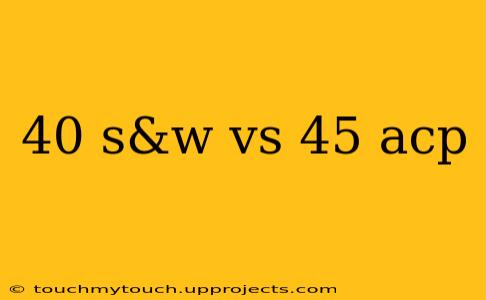Choosing the right caliber for self-defense or other shooting applications can be a daunting task. Two popular choices often debated are the 40 S&W and the .45 ACP. This in-depth comparison will explore the key differences between these two cartridges, helping you make an informed decision based on your specific needs and preferences.
Ballistics: Power and Penetration
The fundamental difference lies in their ballistic performance. The .45 ACP, with its larger diameter (.452 inches) and heavier bullet weight, delivers significantly more stopping power due to its larger wound cavity. However, the 40 S&W (0.40 inches) boasts higher velocity, leading to flatter trajectories and potentially deeper penetration.
Key Ballistic Differences:
- .45 ACP: Larger diameter, heavier bullets, lower velocity, higher stopping power (hydrostatic shock), potentially less penetration.
- 40 S&W: Smaller diameter, lighter bullets (generally), higher velocity, potentially greater penetration, less stopping power compared to .45 ACP.
It's important to note that "stopping power" is a complex concept influenced by factors beyond just bullet size and velocity, including bullet construction, placement of shot, and the target's physiology.
Penetration Considerations
While increased penetration might seem advantageous, over-penetration poses a significant risk in populated areas. A round that passes through the intended target and continues into surrounding structures or innocent bystanders is extremely dangerous. Both calibers require responsible handling and shot placement.
Recoil and Controllability
Recoil is a crucial factor in accuracy and follow-up shots. The .45 ACP generally exhibits more recoil than the 40 S&W, making rapid follow-up shots more challenging for some shooters, particularly those with less experience. The 40 S&W's lighter recoil often translates to better controllability and faster target reacquisition.
Capacity and Magazine Size
Many modern handguns chambered in 40 S&W boast higher magazine capacities than their .45 ACP counterparts. This translates to more rounds available in a self-defense scenario. This difference can be significant for those prioritizing carrying a high number of rounds.
Accuracy and Precision
Accuracy is subjective and depends on many factors beyond the cartridge itself, including the firearm, the shooter's skill, and ammunition quality. Both calibers are capable of high accuracy with the right combination of these elements. Generally speaking, the lower recoil of the 40 S&W might give some shooters a slight edge in terms of sustained accuracy during rapid firing.
Ammunition Availability and Cost
Both 40 S&W and .45 ACP are widely available, but price fluctuations can occur. Generally, .45 ACP ammunition tends to be slightly more expensive than 40 S&W, though this can vary depending on the manufacturer, bullet type, and market conditions.
Conclusion: Which Caliber is Right for You?
The "better" caliber depends entirely on individual needs and priorities.
Choose .45 ACP if:
- Stopping power is your top priority.
- You prioritize a larger, heavier bullet.
- Recoil isn't a major concern.
Choose 40 S&W if:
- You value higher capacity and faster follow-up shots.
- Lighter recoil is crucial for comfortable shooting.
- You need a cartridge with potentially better penetration.
Ultimately, the best way to determine which caliber is right for you is to rent or borrow firearms in both calibers and experience them firsthand at a shooting range. Consider your shooting style, physical capabilities, and intended use before making a decision. Proper training and responsible gun handling practices are essential regardless of the caliber chosen.
